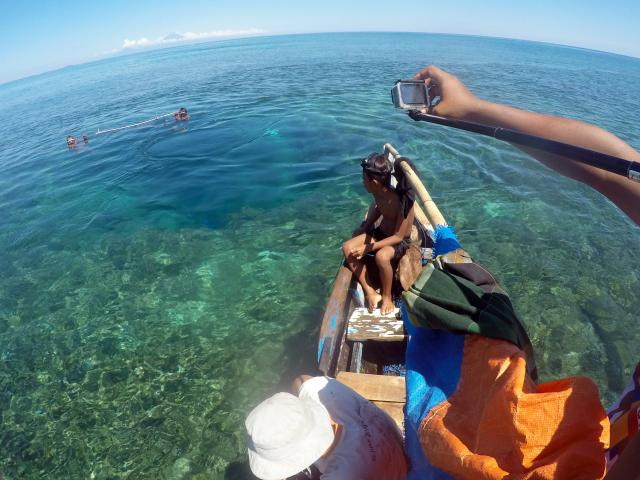25/09/2019 | Climate change, ocean acidification, overfishing – coral reefs are exposed to many damaging influences. A team of scientists from the Leibniz Centre for Tropical Marine Research (ZMT) has now come across another threat that could have far more impact than previously thought: submarine groundwater discharge. They have detailed their findings in the journal Limnology and Oceanography.
Many divers are familiar with the phenomenon: when diving through a coral reef, the water can suddenly become blurred and much colder, which is often the result of groundwater seeping through the seabed after having made its way from the land over many kilometres through rock and sand layers.
Submarine groundwater springs are widespread all over the world, but have hardly been studied by scientists to date. According to previous estimates, such springs account for up to 10% of the water discharged from land into the sea. They are particularly common in volcanic regions, where the groundwater can flow easily along fissures and cracks through the underground.
Together with partners from the Indonesian Research Centre of Geotechnolgy, Till Oehler, geologist at ZMT, discovered a large number of submarine springs in a coral reef off Lombok, a volcanic island in Indonesia. On closer inspection they found deep cracks and crevices in the reef alongside the springs; in some cases large craters with a diameter of up to 16 metres had formed. Coral debris accumulated on the seabed, and algae had started to overgrow the reef.
Measurements by the researchers showed that a large amount of water is discharged from the individual springs in the reef: up to five litres per second. “This type of groundwater is usually heavily polluted and very rich in nutrients such as nitrate or phosphate, as it carries fertiliser and wastewater from industry, agriculture and settlements. Lombok and many other islands in the region have virtually no sewage treatment plants,” reports Dr. Till Oehler.
To investigate water chemistry, the geologists took groundwater samples from the reef and from wells on land. They found that the nitrate levels at the reef springs were 40 times higher than in the surrounding water. They were also able to trace the origin of the reef springs, which was located on Lombok in a densely populated valley region.
Coral reefs thrive best in nutrient-poor, clear water. An excess of nutrients can lead to strong algae growth. Algae then compete with corals for the settlement in the reef, resulting in overgrowth and eventual death of the corals. “In addition, the submarine groundwater springs produce water which is more acidic than seawater and can impair skeleton formation and thus coral growth.”, explains Professor Nils Moosdorf, who leads the working group “Submarine Groundwater Discharge” at ZMT.
Freshwater springs, as described by the researchers, were also found in reefs off Hawaii, Mexico and the Philippines. The ZMT scientists assume that they are widespread. Along the Pacific, for example, where continental plates collide at the Pacific Ring of Fire, islands of volcanic origin line up in front of Australia and Southeast Asia, like pearls on a chain. The area is rich in coral reefs and one of the most biodiverse marine regions on Earth and the researchers also suspect further groundwater springs there.
“Groundwater is fed by rain which is especially high during the monsoon season,” says Professor Moosdorf. “According to forecasts on the consequences of climate change, rainfall in the region is expected to become even more intense. This could lead to a further increase in submarine groundwater discharge and its nutrient load.”
Publication
Oehler, T., Bakti, H., Lubis, R. F., Purwoarminta, A., Delinom, R., & Moosdorf, N. (2019). Nutrient dynamics in submarine groundwater discharge through a coral reef (western Lombok, Indonesia). Limnology and Oceanography, lno.11240. https://doi.org/10.1002/lno.11240





